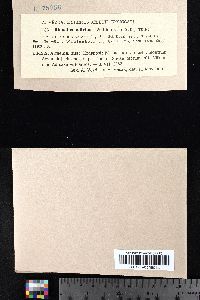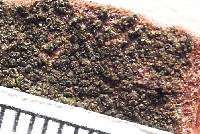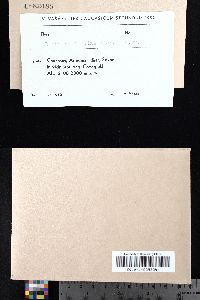
- Home
- Search
- Images
- Species Checklists
- US States: O-Z >
- US National Parks
- Central America
- South America
- US National Parks
- Southern Subpolar Region
|
|
|
|
Family: Physciaceae
[Lecanora milvina (Wahlenb.) Ach., moreLichen milvinus (Wahlenb.) Wahlenb., Pachysporaria milvina (Wahlenb.) M. Choisy, Parmelia milvina Wahlenb.] |
MB#357190 Type. NORWAY. FINNMARK. Jansnäset ad Talviig, 1802, G. Wahlenberg s.n. (UPS ‑ holotype (Mayrhofer & Poelt 1979), Ach‑BM 425 ‑ authentic!). Exsiccata. Arnold Lich. Exs. 1160, 1761 (MIN); Hepp Flechten Eur. 208 (NY as Psora caesiella); Plantae Graecenses, Lich. 172 (COLO). Description. Thallus comprised of discrete, thin verrucae at first, ca. 0.20 mm wide, thick, areolate when mature; areoles to 0.50-1.00 mm wide, plane or more usually rugose; surface grey‑brown to dark copper-brown, matt; margin determinate; prothallus sometimes present, black, entire or fimbriate; vegetative propagules absent. Apothecia frequent, subinnate becoming broadly attached, contiguous, sometimes angular by compression, to 0.30-0.80 mm in diam.; disc dark brown to black, persistently plane; thalline margin concolourous with thallus, 0.05-0.10 mm wide, entire, persistent; excipular ring absent. Apothecial Anatomy. Thalline exciple 60-100 µm wide laterally; cortex 10-15 µm wide; epinecral layer absent; crystals absent in cortex and medulla; cortical cells to 4.5-7.0 µm wide, pigmented; algal cells to 9.0-17.0 µm long; thalline exciple 50-90(-140) µm below; cortex 10-25 µm wide, cellular, often pigmented; proper exciple hyaline, 10-20 µm wide laterally, expanding to 20-40 µm at periphery; hypothecium hyaline, 55-100 µm deep; hymenium 75-120 µm high, not inspersed; paraphyses 1.5-2.5 µm wide, not conglutinate, with apices to 3.5-5.5 µm, lightly pigmented but immersed in dispersed pigment, forming a red‑brown epihymenium; asci 40-70 x 15-23 µm. Ascospores (4-)8/ascus, Type A development, Milvina-type, (15.5-)18.0-19.0(-22.0) x (7.5-)9.5-10.5(-12.0) µm, average l/b ratio 1.7-1.9, lumina angular at first (Physcia-like), quickly becoming irregular with broad or poorly developed canals, then rounded, almost filling each cell, with thin apical walls, endospore wall sometimes pigmented in part, lightly pigmented bands around cells of some spores, mature spores constricted at septum; torus well developed; walls ornamented. Pycnidia immersed; conidia bacilliform, 4.0-5.0 x 1.5 µm. Chemistry. Spot tests all negative; secondary metabolites not detected. Substrate and Ecology. Recorded on granite, quartzite and other acidic rocks, also on sandstone, limestone, volcanic rock, and weakly alkaline rocks, at elevations of 900-3 660 m in the United States. It has been collected with R. confragosa, R. obnascens, R. parasitica, R. verruciformis and is sometimes lichenicolous on other crustose lichens. Distribution. Found in the Rocky Mountains, Sierra Nevada, Cascade and Coastal Ranges. The species has been recorded as far north as Montana and should be sought in the mountains north of the international border. Californian records of R. tephraspis (Tuck.) Herre (Herre 1910) belong to R. milvina. The species is scattered in Scandinavia and is widely distributed in the mountains of central and southern Europe, North Africa and Asia. It is rare in Scotland (Mayrhofer and Moberg, 2002). Notes. Rinodina milvina is characterized by its rather thick and dark brown to often copper-brown thallus and spore type. It is, nevertheless, a rather variable species with respect to spore structure and size, and thallus morphology but is unlikely to be mistaken for other species in western North America. Young thalli may have a similar habit to thalli of R. parasitica, which also are dark brown, but that species is well distinguished by its smaller, Physcia-type spores. Well developed, thick thalli, usually with a rugose surface, have a tendency for areoles to proliferate marginally and overgrow older areoles. The species resembles R. arnoldii H. Mayrhofer & Poelt rather closely in thallus morphology as has already been stated by Mayrhofer and Poelt (1979). However, the apothecia of R. arnoldii may become convex, the thallus is a greyer shade of brown and, more importantly, the spores are broader, have Pachysporaria-like lumina, a more darkly pigmented endospore wall than R. milvina, and a tendency for the cells to be unequal in size (Mayrhofer and Sheard, 1988). Rinodina arnoldii is an arctic species that occurs in West Greenland and is therefore likely to be found in the Canadian Arctic. Specimens examined. U.S.A. ARIZONA. Apache Co., Mount Baldy Wilderness, T.H. Nash 34862 (ASU); Cochise Co., Portal, 1957, W.A. Weber (COLO); Rustlers Park, W.A. Weber 36926 (COLO, DUKE); Coconino Co., Jacks Canyon, T.H. Nash 40264; Mogollon Rim, T.H. Nash 29572; Gila Co., Four Peaks, T.H. Nash 25413, 25414; Pine Canyon, T.H. Nash 39463; Workman Falls, T.H. Nash 28452; Graham Co., Mount Graham, T.H. Nash 4198; Pinaleno Mountains, T.H. Nash 16516, 16647; Santa Cruz Co., Santa Rita Mountains, T.H. Nash 19564. CALIFORNIA. Alpine Co., Carson‑Iceberg Wilderness, B.D. Ryan 24639; El Dorado Co., Fallen Leaf Lake, B.D. Ryan 23330 (all ASU); Mariposa Co., Yosemite Valley, 1900, H.E. Hasse; San Bernadino Co., San Bernardino Mts., 1899, H.E. Hasse; San Mateo Co., Stanford University, 1904, A.C. Herre; Santa Clara Co., Searsville Ridge, A.C. Herre 539 (all NY); Siskiyou Co., Marble Mountain Wilderness, B.D. Ryan 25245c, 25271, 25272 (ASU); Tulare Co., Yucca Creek, C.M. Wetmore 50489 (MIN). COLORADO. Boulder Co., Boulder, W.A. Weber 8494 (DUKE, FH); Boulder Canyon, 1977, R.A. Anderson (GZU); Buckingham Park, W.A. Weber 4703A (COLO, UPS); Gregory Canyon, 1957, W.A. Weber (ABSL, MIN, MSC); W.A. Weber 8494 (COLO, UC. WIS); W.A. Weber 24428; Rabbit Mountain, R.A. Anderson 20363 (both COLO); Rocky Mountain Nat. Park, R.A. Anderson 6712 (COLM); Wild Basin, W.A. Weber 2872; R.A. Anderson 1530, 4144 (all COLO); Chaffee Co., Sawatch Range, R.A. Anderson 5563 (COLM); Clear Creek Co., S Idaho Springs, 1977, R.A. Anderson (GZU); Fremont Co., Coaldale, S. Shushan 14882; Grand Co., Cascade Falls, R.A. Anderson 4329; Devil's Staircase, R.A. Anderson 4432; Granite Falls, R.A. Anderson 2455 (all COLO); Rocky Mountain Nat. Park, R.A. Anderson 5641, 5650 (COLM); Jefferson Co., Bull Gulch, W.A. Weber 18940 (COLO); Evergreen, J.W. Sheard 4698 (SASK); Larimer Co., Big Thompson River, R.A. Anderson 3785; Fairchild Mountain, R.A. Anderson 3593 (both COLO); Twin Sisters Mountain, W. Kiener 6287 (MIN); Montrose Co., Paradox Valley, W.A. Weber 31346 (COLO); Rio Grande Co., South Fork, C.M. Wetmore 17253 (MIN, WIS). MONTANA. Flathead Co., Bigfork Dam, B. McCune 10107, 10114 (WIS); Gallatin Co., Hyalite Canyon, B. McCune 25972 (personal herb.); Lake Co., Mission Range, B. McCune 8727 (MICH); Missoula Co., Missoula, R.A. Anderson 5105, 5168 (COLM); Ravalli Co., Mill Creek Canyon, B. McCune 11959 (personal herb.); Stetsonville, R.A. Anderson 5080 (COLM); Bittertooth Mountains, B. McCune 20902. OREGON. Douglas Co., 3 km S Tenmile, B. McCune 23846; Wallowa Co., 1 km N Shady Camp, B. McCune 21789 (all personal herb.). SOUTH DAKOTA. Fall River Co., 1.3mi S Gull School, C.M. Wetmore 10745; Meade Co., 2.5 mi E Piedmont, C.M. Wetmore 10362; Fort Meade, C.M. Wetmore 10503 (all MSC); Pennington Co., Silver City, R.A. Anderson 20649 (COLO). TEXAS. Brewster Co., Big Bend Nat. Park, C.M. Wetmore 19540 (MIN); Chisos Mountains, R.A. Anderson 18766 (COLO). UTAH. Duchesne Co., Swift Creek Basin, C. Newberry 1436 (BRY); Washington Co., Zion Nat. Park, T.H. Nash 15550 (ASU). WYOMING. Crook Co., 16 mi N Sundance, C.M. Wetmore 9809 (MSC). Selected References. Wetmore (1968 including R. guzzinii, R. obnascens and R. parasitica), Mayrhofer & Poelt (1979 Abb. 2), Mayrhofer (1984a Abb. 2c), Fox & Purvis (1992), Thomson (1997), Giralt (2001 Plate X: B), Mayrhofer & Moberg Fig. 3:9, p. 105), Sheard (2004 Fig. 63). Nash, T.H., Ryan, B.D., Gries, C., Bungartz, F., (eds.) 2004. Lichen Flora of the Greater Sonoran Desert Region. Vol 2. Thallus: crustose, of discrete, small verrucae at first, up to c. 0.2 mm wide, thick and areolate when mature, areoles up to 0.5-1 mm wide, plane or more usually rugose surface: gray-brown to dark brown, dull; margin: determinate; prothallus: sometimes present, black, entire or fimbriate; vegetative propagules: absent Apothecia: frequent, subinnate becoming adnate, contiguous, sometimes angular by compression, up to 0.3-0.8 mm in diam. disc: dark brown to black, persistently plane thalline margin: concolorous with thallus, 0.05-0.1 mm wide, entire, persistent; excipular ring: absent thalline exciple: 60-100 µm wide laterally; cortex: 10-15 µm wide; cells: up to 4.5-7 µm wide, pigmented; algal cells: up to 9-17 µm in diam.; thalline exciple 50-90(-140) µm below; cortex: 10-25 µm wide, cellular, often pigmented proper exciple: hyaline, 5-20 µm wide laterally, expanding to 10-40 µm at periphery hymenium: 65-120 µm tall, paraphyses: 1.5-2.5 µm wide, not conglutinate, with apices up to 3.5-5.5 µm, lightly pigmented but immersed in dispersed pigment, forming a red-brown epihymenium; hypothecium: hyaline, (30-)55-100 µm thick asci: clavate, 40-70 x 15-23 µm, 8-spored ascospores: brown, 1-septate, broadly ellipsoid, type A development, Milvina-type, (15-)18.5-19.5(-23) x (8-)10.5-11(-13.5) µm, lumina angular at first, quickly becoming irregular with broad or poorly developed canals, then rounded and almost filling each cell, endospore wall sometimes pigmented in part, resulting in lightly pigmented bands around cells of some spores, mature spores constricted at septum; torus: well developed; walls: ornamented (Fig. 63) Pycnidia: immersed; conidia: bacilliform, 4-5 x 1.5 µm Spot tests: all negative Secondary metabolites: none detected. Substrate and ecology: on acidic and weakly alkaline rocks, and sometimes epiphytic on other crustose lichens, at elevations of 900-3660 m in North America World distribution: Scandinavia and mountains of central and southern Europe, North Africa, Asia and western United States Sonoran distribution: Arizona and a single record from San Bernadino County, California, at 1700-3000 m. Notes: Rinodina milvina is a rather variable species with respect to spore structure and size, and thallus morphology but is unlikely to be mistaken for other species in the Sonoran region. Young thalli may have a similar habit to R. parasitica that also are dark brown but this species is easily distinguished by its smaller, Physcia-type spores. Well developed, thick thalli, usually with a rugose surface, have a tendency for areoles to proliferate marginally and overgrow older areoles. Californian records of R. tephraspis (Tuck.) Herre (Herre 1910) belong to R. milvina. |















































